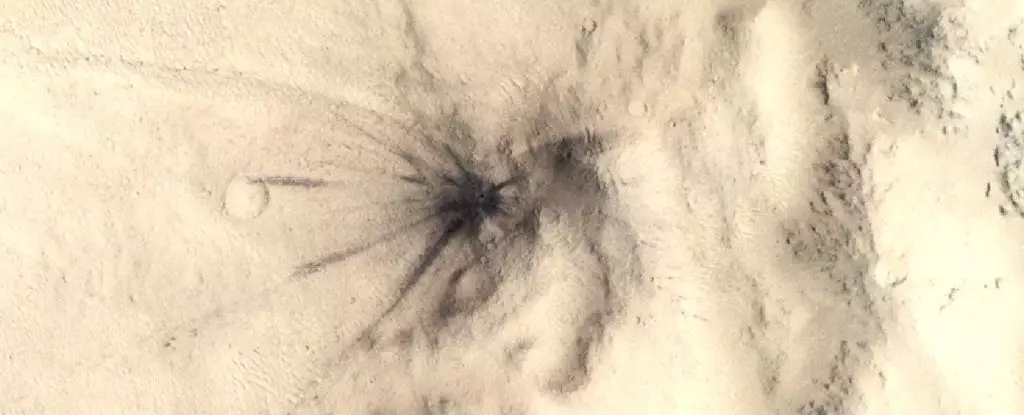Mars, often referred to as the Red Planet, has long captivated scientists and enthusiasts alike with its enigmatic surface and history. Traditionally perceived as a geologically dormant world, new research has thrown this assumption into disarray. Groundbreaking studies leveraging artificial intelligence (AI) to analyze seismic data reveal that the powerful martian quakes—known as marsquakes—have multifaceted origins, many of which stem not from tectonic or volcanic activity within the planet but from the gradual bombardment by meteoroids. This revelation has profound implications for our understanding of Mars’s geological evolution and raises questions about how terrestrial planets like Earth, Venus, and Mars have formed and evolved over time.
A closer examination of this new research unveils that a seismic station—InSight—operating from 2018 to 2022 played a pivotal role in unveiling the hidden dynamics of Mars. Initially deployed to monitor subsurface activity, InSight recorded over 1,300 marsquakes, a number that far exceeds prior expectations of a geologically quiet planet. The groundbreaking nature of this study lies not only in the number of detections but also in the origin of these quakes, which are now known to be significantly influenced by external impacts.
The research undertaken by planetologist Valentin Bickel and colleagues showcases a riveting interplay between seismic activity and the influx of meteoroids. Utilizing a machine learning algorithm, the scientists meticulously analyzed the emergence of 123 new impact craters while correlating these events with InSight’s seismic data. Astonishingly, they linked 49 seismic occurrences to distinct impacts, uncovering a new understanding of how often Mars is bombarded. With estimates suggesting that the rate of significant impacts is 1.6 to 2.5 times higher than previously acknowledged, this research urges a reevaluation of our expectations regarding Mars’s feisty geological behavior.
The implications of this research extend into several realms of planetary science, particularly in the context of Martian geological history. Former assumptions held that most seismic activity on Mars erupted from internal geological processes. However, the newly gained understanding of the significant role played by impacts necessitates a shift in perspective. One telling example is the examination of a notable impact site located near Cerberus Fossae, a geologically young volcanic plain characterized by seismic restlessness. Researchers identified that several high-frequency seismic signals thought to be generated internally may instead be triggered by external impacts. This prompts questions about the volcanic and tectonic history of Mars, ultimately suggesting that much remains to be discovered.
Exploring the Seismic Highways of Mars
Perhaps the most revolutionary aspect of the findings pertains to how seismic waves propagate across the Martian interior. Prior studies indicated that impact-generated seismic waves were restricted to the outer layer of Mars, predominantly the crust. However, this assumption has now been compellingly challenged. Instead, the seismic analysis conducted by Bickel’s team shows that these waves can traverse into and beneath the mantle, establishing what has been termed a “seismic highway.” This profound notion not only enriches our comprehension of wave propagation but also signifies that interpretations of Mars’s internal structure require extensive reevaluation.
The realization that many marsquakes might be sourced further from the InSight lander than previously thought dramatically impacts our understanding of the planet’s subsurface composition. It suggests a more complex interior structure than earlier models indicated and highlights the possibility of diverse materials within the Martian mantle.
A Brave New Era in Martian Studies
As we stand on the precipice of a new era in Martian studies, the research discussed here positions Mars as a planet of immense complexity rather than a static, quiet world. The realization that the Red Planet frequently endures meteoroid impacts reshapes our entire perspective on not only Martian geology but also on planetary formation across the Solar System.
This research enables scientists to delve deeper into the mysteries that Mars presents––questions about not only quakes and impacts but also atmospheric interactions and surface evolution. The Red Planet is far from lifeless; instead, it is a dynamic world that warrants further exploration and understanding. As technology and methodologies advance, so too will our explorations, leading to a richer and more nuanced understanding of Mars and its place in the cosmos. The challenging journey is just beginning, and it is one that promises to unravel age-old questions about the processes that govern planetary behavior and evolution.


Leave a Reply